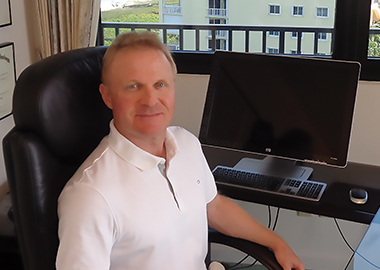Axel Rohde, founder and owner of MicroCFD once saw a picture of a marathon runner in someone’s office with the following words: “The race is not always to the swift, but to those who keep on running.” This left a great impact on him. “Getting my PhD in aerospace engineering had more to do with my perseverance and endurance than anything else. While growing MicroCFD for the past two decades, I applied that same strategy,” says Axel. MicroCFD was founded in 2001. At the time computational fluid dynamics (CFD) software was either too costly or too complex for a novice user to run on a personal computer. Yet there was emerging interest among certain professionals and hobbyists for aerodynamic simulations. Their 2D virtual wind tunnel fit that market niche, and with its easy to use graphical user interface and tutorials, anyone could get up and running in a matter of hours.
MicroCFD offers state-of-the-art computational fluid dynamics software and consulting for aerodynamic simulations. Axel and his small team of aerospace engineers attend conferences every year and publish papers occasionally, so they consider themselves at the forefront of CFD technology. “I am primarily in charge of software development, while my team members handle most of the consulting work.” Adds Axel. MicroCFD provides fluid flow and heat transfer analysis for a variety of applications, ranging from automotive, aerospace and marine, to electronic and biomedical engineering. Their suite of virtual wind tunnels was developed for external aerodynamic flow only. For all other flow scenarios, such as hydrodynamics, internal flow with possible heat transfer, or chemically reacting flow, they use in-house developed research code and open-source CFD applications.
Explaining how his idea evolved with the introduction of technologies, Axel says, in 2000 a single core processor could solve a 2D or axissymmetric aerodynamic flow in a few hours. But for an intricate 3D air flow such a processor was busy for weeks. By 2010 multi-core CPUs with large shared caches cut that simulation time down to a matter of days. By 2015 the emergence of many-core GPUs, capable of general-purpose computing, made it possible to solve a complex 3D aerodynamic flow overnight. The MicroCFD 3D virtual wind tunnel was designed to run on such GPUs, and so far it has been unparalleled in computational speed and flow resolution. One of MicroCFD’s aerospace clients used their 3D virtual wind tunnel to study the aerodynamic stability of space vehicle designs during atmospheric reentry. This requires a large number of CFD simulations at varying altitude, Mach number, and pitch angle. The researcher used the space shuttle orbiter as a baseline study, since so much data is available in the literature for comparison, and to his surprise the simulation results were very well aligned with flight data published by NASA.
Axel is inspiring and empowering young entrepreneurs across industries into becoming great leaders with technical know-how. According to him equally important to technical know-how is the ability to communicate the same. Good leadership requires good communication skills, both verbal and written. And these skills can be trained through a number of activities like teaching a course, giving seminars, or presenting at conferences. “Although I have never viewed any particular person as my role model, many successful individuals from the tech industries, who started a company with just a basic idea, inspired me when I was young,” states the steadfast leader. “Today, I would say Elon Musk is the greatest engineering leader of our time.”
Talking about the future, Axel discusses that while cloud computing is on everyone’s mind these days, very few of their clients have requested it so far. “There is a natural distrust to upload a proprietary design onto a cloud computing platform, and most of our clients are far more comfortable with running their simulations on their in-house PCs,” he adds. “We are hoping to shift our main revenue from consulting to software licensing by 2025, which will require a network of sales partners around the globe. Finding sales representatives with excellent communication skills who are also technically savvy will be the real challenge. But nevertheless we will look towards the future with open minds.”


